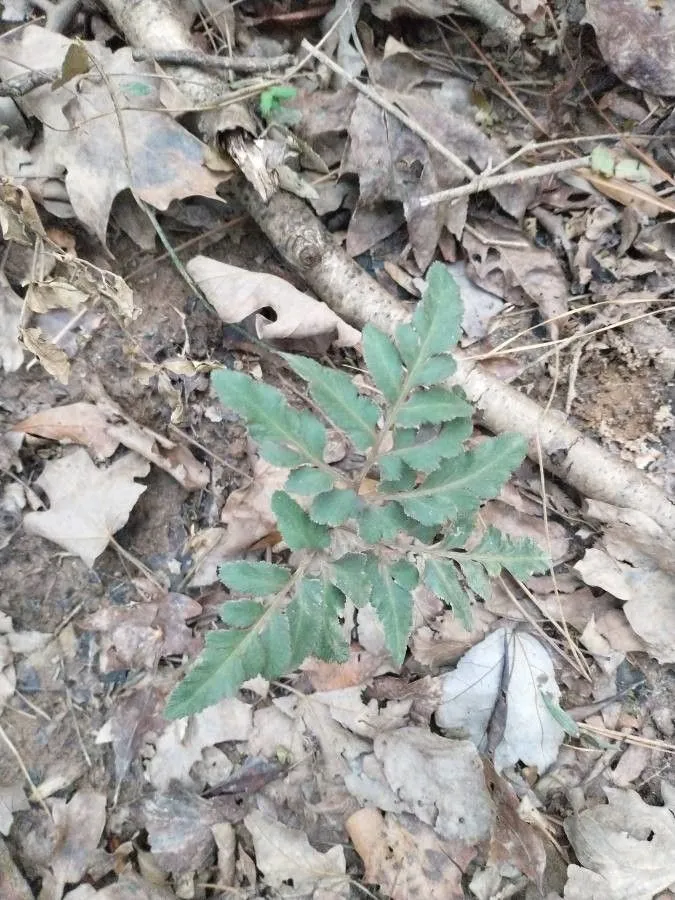
Author: Spreng.
Bibliography: Anleit. Kenntn. Gew. 3: 172 (1804)
Year: 1804
Status: accepted
Rank: species
Genus: Botrychium
Vegetable: Unknown
Observations: E. Canada to C. & E. U.S.A., Hiapaniola, Jamaica
The Cutleaf Grapefern, known scientifically as Botrychium dissectum, is a notable species within the Ophioglossaceae family. Described by the author Spreng. in 1804, this unique botanical specimen can be traced back to its initial classification in “Anleit. Kenntn. Gew.,” where it is meticulously detailed on page 172 of the third volume.
This fern stands out due to its distinctly lobed and finely dissected fronds, which bear a striking resemblance to grape leaves, lending it the common name of Cutleaf Grapefern. It thrives across a reasonably wide geographical range, spanning from Eastern Canada, traversing the Central and Eastern regions of the United States, and extending its presence to the warmer climates of Hispaniola and Jamaica.
The Cutleaf Grapefern inhabits various environments, adapting well to the moist, shaded undergrowth of forests and the partial sunlight of meadows. Its resilience and adaptability make it a fascinating subject of ecological and botanical studies.
The fern typically emerges in autumn, with sterile leaflets that persist through the winter before withering away in the early stages of spring. This seasonal behavior is a key characteristic that aids in its identification and study throughout its growing regions.
As a member of the Ophioglossaceae family, Botrychium dissectum shares common traits with its relatives, including the presence of a single fertile spike, which arises from the base of the sterile leaf. This sporangial spike bears clusters of spores, essential for the fern’s reproductive cycle.
The study of the Cutleaf Grapefern is not only significant for understanding botanical diversity but also for conservation efforts, as its habitats often coincide with regions facing ecological pressures. Ensuring the preservation of such species demands a comprehensive understanding of their life cycles, environmental preferences, and the broader ecological interactions within their habitats.
In summary, Botrychium dissectum, or the Cutleaf Grapefern, is an ecologically and botanically significant species, distinguished by its intricately cut foliage and widespread distribution from northern to tropical regions. Its study provides valuable insights into the diversity and adaptability of ferns within the Ophioglossaceae family and underscores the importance of conserving its varied habitats.
En: Cutleaf grapefern, Cut-leaf grape-fern, Dissected grapefern
Fr: Botryche découpé
© copyright of the Board of Trustees of the Royal Botanic Gardens, Kew.
© copyright of the Board of Trustees of the Royal Botanic Gardens, Kew.
Taken Jan 24, 2021 by Daniel Burken (cc-by-sa)
Taken Oct 12, 2020 by Brenda Johnson (cc-by-sa)
Taken Sep 6, 2022 by Bentley Reynolds (cc-by-sa)
Taken Dec 25, 2021 by Caleb Usadi (cc-by-sa)
Taken Nov 16, 2021 by Caroline Vee (cc-by-sa)
Taken Oct 6, 2021 by dixie cousins (cc-by-sa)
Taken Nov 4, 2018 by Annie Elle (cc-by-sa)
Taken Nov 12, 2002 by EOL − Steven J. Baskauf (cc-by-nc-sa)
Taken Sep 25, 2021 by J B (cc-by-sa)
Taken Oct 5, 2020 by Robert Breeding (cc-by-sa)
Taken Nov 14, 2020 by Lily Jones (cc-by-sa)
Taken Oct 18, 2002 by EOL − Steven J. Baskauf (cc-by-nc-sa)
Taken Nov 6, 2014 by EOL − Kyle Jones (cc-by-nc)
Taken Nov 23, 2014 by EOL − Matt Rung (cc-by-nc)
Taken Nov 20, 2014 by EOL − Robert L Curtis (cc-by-nc-sa)
Taken Nov 20, 2014 by EOL − Robert L Curtis (cc-by-nc-sa)
Taken Jul 4, 2014 by EOL − Jennifer Clevinger (cc-by-nc)
Taken Mar 21, 2015 by EOL − Suzanne Cadwell (cc-by-nc)
Family: Myrtaceae Author: (F.Muell.) K.D.Hill & L.A.S.Johnson Bibliography: Telopea 6: 402 (1995) Year: 1995 Status:…
Family: Rubiaceae Author: Pierre ex A.Froehner Bibliography: Notizbl. Bot. Gart. Berlin-Dahlem 1: 237 (1897) Year:…
Family: Sapindaceae Author: Koidz. Bibliography: J. Coll. Sci. Imp. Univ. Tokyo 32(1): 38 (1911) Year:…
Family: Asteraceae Author: A.Gray Bibliography: Pacif. Railr. Rep.: 107 (1857) Year: 1857 Status: accepted Rank:…
Family: Fabaceae Author: Medik. Bibliography: Vorles. Churpfälz. Phys.-Ökon. Ges. 2: 398 (1787) Year: 1787 Status:…
Family: Aspleniaceae Author: (Cav.) Alston Bibliography: Bull. Misc. Inform. Kew 1932: 309 (1932) Year: 1932…